Ramsay Healthcare UK: Operation Management, Models, and KPI Analysis
VerifiedAdded on 2023/06/18
|11
|3660
|492
Report
AI Summary
This report provides an analysis of operation management at Ramsay Healthcare UK, a healthcare firm based in the UK, focusing on problem identification, KPI implementation, and the application of various models. It identifies quality issues such as hospital cleaning, equipment usage, and misdiagnosis, suggesting the use of KPIs like medical equipment utilization and patient wait times to address these problems. The report employs the Ishikawa diagram and FMEA to analyze potential causes of operational failures and their impact, along with SWOT and PESTLE analyses to assess the company's strategic position and external environment. Ultimately, the report aims to provide insights into improving operational efficiency and service quality within Ramsay Healthcare UK, emphasizing the importance of effective management, maintenance of equipment, and patient satisfaction.
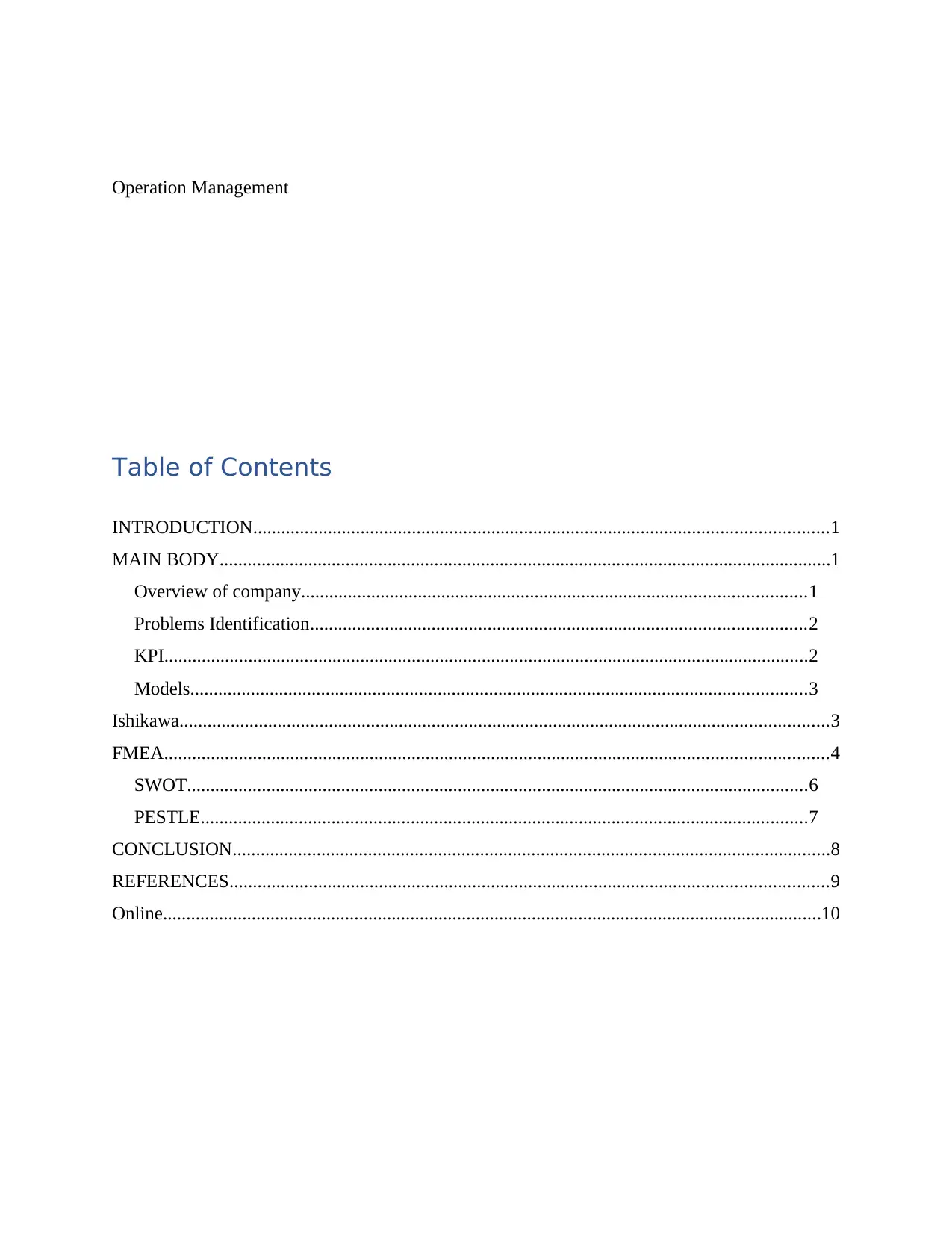
Operation Management
Table of Contents
INTRODUCTION...........................................................................................................................1
MAIN BODY...................................................................................................................................1
Overview of company............................................................................................................1
Problems Identification..........................................................................................................2
KPI..........................................................................................................................................2
Models....................................................................................................................................3
Ishikawa...........................................................................................................................................3
FMEA..............................................................................................................................................4
SWOT.....................................................................................................................................6
PESTLE..................................................................................................................................7
CONCLUSION................................................................................................................................8
REFERENCES................................................................................................................................9
Online.............................................................................................................................................10
Table of Contents
INTRODUCTION...........................................................................................................................1
MAIN BODY...................................................................................................................................1
Overview of company............................................................................................................1
Problems Identification..........................................................................................................2
KPI..........................................................................................................................................2
Models....................................................................................................................................3
Ishikawa...........................................................................................................................................3
FMEA..............................................................................................................................................4
SWOT.....................................................................................................................................6
PESTLE..................................................................................................................................7
CONCLUSION................................................................................................................................8
REFERENCES................................................................................................................................9
Online.............................................................................................................................................10
Paraphrase This Document
Need a fresh take? Get an instant paraphrase of this document with our AI Paraphraser
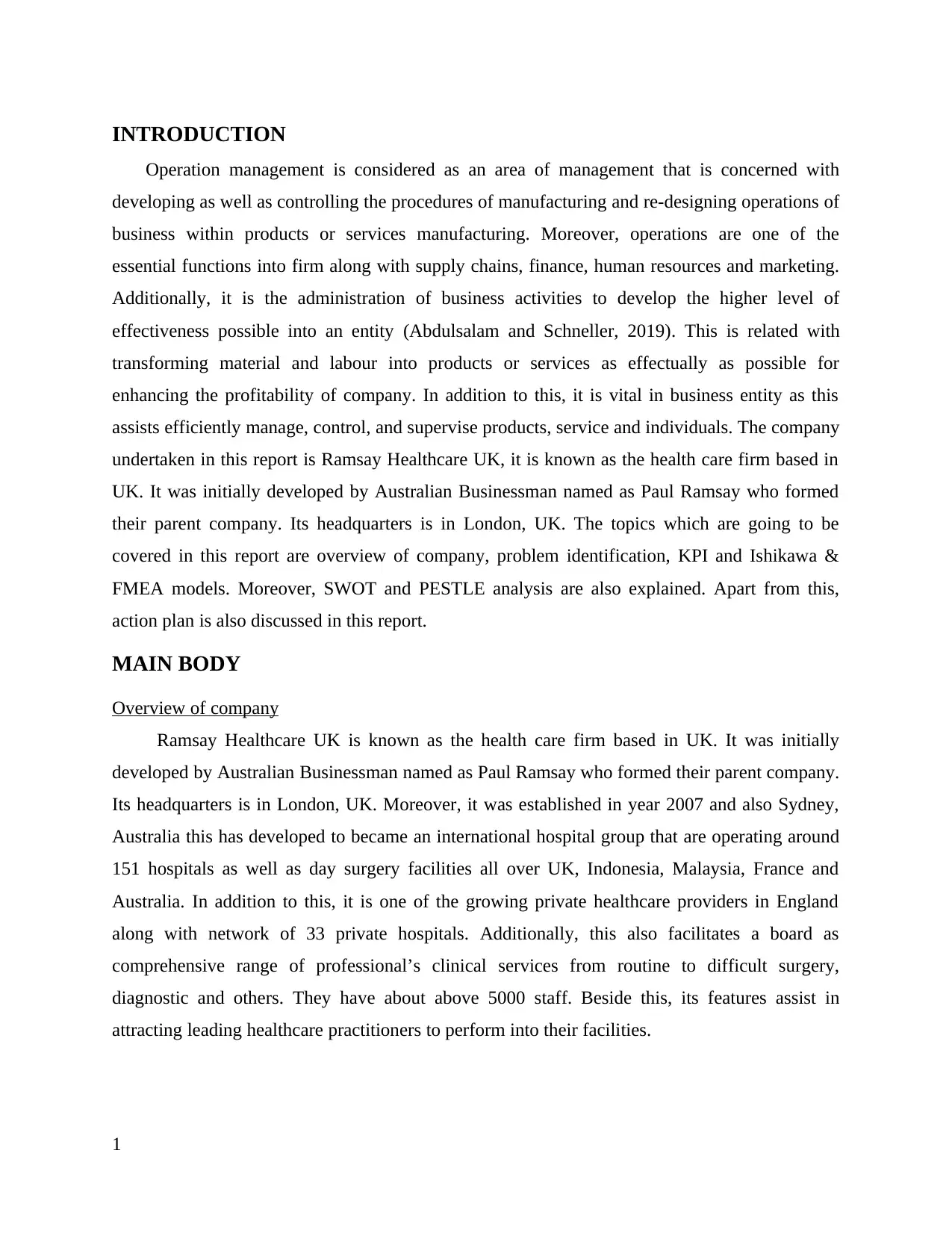
INTRODUCTION
Operation management is considered as an area of management that is concerned with
developing as well as controlling the procedures of manufacturing and re-designing operations of
business within products or services manufacturing. Moreover, operations are one of the
essential functions into firm along with supply chains, finance, human resources and marketing.
Additionally, it is the administration of business activities to develop the higher level of
effectiveness possible into an entity (Abdulsalam and Schneller, 2019). This is related with
transforming material and labour into products or services as effectually as possible for
enhancing the profitability of company. In addition to this, it is vital in business entity as this
assists efficiently manage, control, and supervise products, service and individuals. The company
undertaken in this report is Ramsay Healthcare UK, it is known as the health care firm based in
UK. It was initially developed by Australian Businessman named as Paul Ramsay who formed
their parent company. Its headquarters is in London, UK. The topics which are going to be
covered in this report are overview of company, problem identification, KPI and Ishikawa &
FMEA models. Moreover, SWOT and PESTLE analysis are also explained. Apart from this,
action plan is also discussed in this report.
MAIN BODY
Overview of company
Ramsay Healthcare UK is known as the health care firm based in UK. It was initially
developed by Australian Businessman named as Paul Ramsay who formed their parent company.
Its headquarters is in London, UK. Moreover, it was established in year 2007 and also Sydney,
Australia this has developed to became an international hospital group that are operating around
151 hospitals as well as day surgery facilities all over UK, Indonesia, Malaysia, France and
Australia. In addition to this, it is one of the growing private healthcare providers in England
along with network of 33 private hospitals. Additionally, this also facilitates a board as
comprehensive range of professional’s clinical services from routine to difficult surgery,
diagnostic and others. They have about above 5000 staff. Beside this, its features assist in
attracting leading healthcare practitioners to perform into their facilities.
1
Operation management is considered as an area of management that is concerned with
developing as well as controlling the procedures of manufacturing and re-designing operations of
business within products or services manufacturing. Moreover, operations are one of the
essential functions into firm along with supply chains, finance, human resources and marketing.
Additionally, it is the administration of business activities to develop the higher level of
effectiveness possible into an entity (Abdulsalam and Schneller, 2019). This is related with
transforming material and labour into products or services as effectually as possible for
enhancing the profitability of company. In addition to this, it is vital in business entity as this
assists efficiently manage, control, and supervise products, service and individuals. The company
undertaken in this report is Ramsay Healthcare UK, it is known as the health care firm based in
UK. It was initially developed by Australian Businessman named as Paul Ramsay who formed
their parent company. Its headquarters is in London, UK. The topics which are going to be
covered in this report are overview of company, problem identification, KPI and Ishikawa &
FMEA models. Moreover, SWOT and PESTLE analysis are also explained. Apart from this,
action plan is also discussed in this report.
MAIN BODY
Overview of company
Ramsay Healthcare UK is known as the health care firm based in UK. It was initially
developed by Australian Businessman named as Paul Ramsay who formed their parent company.
Its headquarters is in London, UK. Moreover, it was established in year 2007 and also Sydney,
Australia this has developed to became an international hospital group that are operating around
151 hospitals as well as day surgery facilities all over UK, Indonesia, Malaysia, France and
Australia. In addition to this, it is one of the growing private healthcare providers in England
along with network of 33 private hospitals. Additionally, this also facilitates a board as
comprehensive range of professional’s clinical services from routine to difficult surgery,
diagnostic and others. They have about above 5000 staff. Beside this, its features assist in
attracting leading healthcare practitioners to perform into their facilities.
1
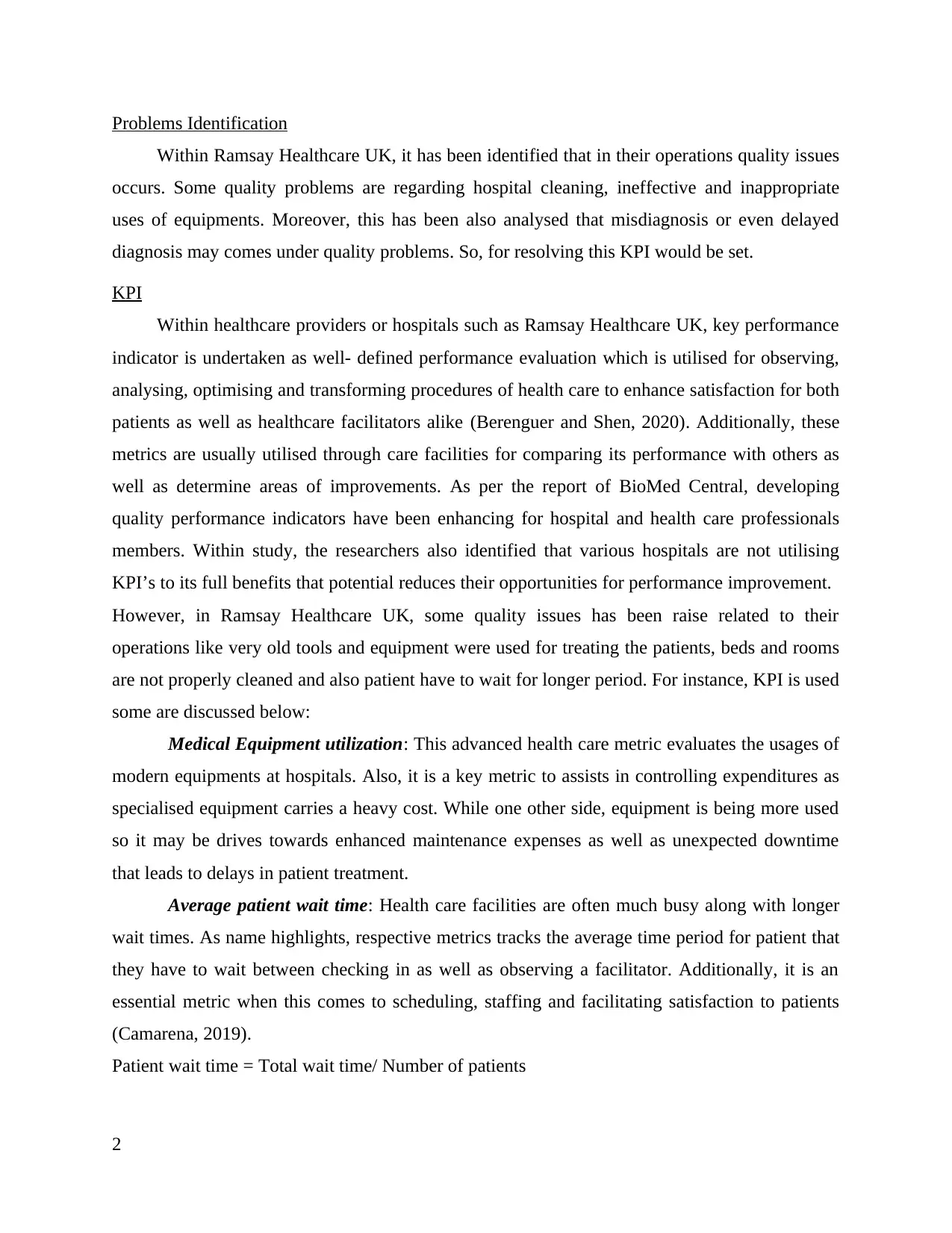
Problems Identification
Within Ramsay Healthcare UK, it has been identified that in their operations quality issues
occurs. Some quality problems are regarding hospital cleaning, ineffective and inappropriate
uses of equipments. Moreover, this has been also analysed that misdiagnosis or even delayed
diagnosis may comes under quality problems. So, for resolving this KPI would be set.
KPI
Within healthcare providers or hospitals such as Ramsay Healthcare UK, key performance
indicator is undertaken as well- defined performance evaluation which is utilised for observing,
analysing, optimising and transforming procedures of health care to enhance satisfaction for both
patients as well as healthcare facilitators alike (Berenguer and Shen, 2020). Additionally, these
metrics are usually utilised through care facilities for comparing its performance with others as
well as determine areas of improvements. As per the report of BioMed Central, developing
quality performance indicators have been enhancing for hospital and health care professionals
members. Within study, the researchers also identified that various hospitals are not utilising
KPI’s to its full benefits that potential reduces their opportunities for performance improvement.
However, in Ramsay Healthcare UK, some quality issues has been raise related to their
operations like very old tools and equipment were used for treating the patients, beds and rooms
are not properly cleaned and also patient have to wait for longer period. For instance, KPI is used
some are discussed below:
Medical Equipment utilization: This advanced health care metric evaluates the usages of
modern equipments at hospitals. Also, it is a key metric to assists in controlling expenditures as
specialised equipment carries a heavy cost. While one other side, equipment is being more used
so it may be drives towards enhanced maintenance expenses as well as unexpected downtime
that leads to delays in patient treatment.
Average patient wait time: Health care facilities are often much busy along with longer
wait times. As name highlights, respective metrics tracks the average time period for patient that
they have to wait between checking in as well as observing a facilitator. Additionally, it is an
essential metric when this comes to scheduling, staffing and facilitating satisfaction to patients
(Camarena, 2019).
Patient wait time = Total wait time/ Number of patients
2
Within Ramsay Healthcare UK, it has been identified that in their operations quality issues
occurs. Some quality problems are regarding hospital cleaning, ineffective and inappropriate
uses of equipments. Moreover, this has been also analysed that misdiagnosis or even delayed
diagnosis may comes under quality problems. So, for resolving this KPI would be set.
KPI
Within healthcare providers or hospitals such as Ramsay Healthcare UK, key performance
indicator is undertaken as well- defined performance evaluation which is utilised for observing,
analysing, optimising and transforming procedures of health care to enhance satisfaction for both
patients as well as healthcare facilitators alike (Berenguer and Shen, 2020). Additionally, these
metrics are usually utilised through care facilities for comparing its performance with others as
well as determine areas of improvements. As per the report of BioMed Central, developing
quality performance indicators have been enhancing for hospital and health care professionals
members. Within study, the researchers also identified that various hospitals are not utilising
KPI’s to its full benefits that potential reduces their opportunities for performance improvement.
However, in Ramsay Healthcare UK, some quality issues has been raise related to their
operations like very old tools and equipment were used for treating the patients, beds and rooms
are not properly cleaned and also patient have to wait for longer period. For instance, KPI is used
some are discussed below:
Medical Equipment utilization: This advanced health care metric evaluates the usages of
modern equipments at hospitals. Also, it is a key metric to assists in controlling expenditures as
specialised equipment carries a heavy cost. While one other side, equipment is being more used
so it may be drives towards enhanced maintenance expenses as well as unexpected downtime
that leads to delays in patient treatment.
Average patient wait time: Health care facilities are often much busy along with longer
wait times. As name highlights, respective metrics tracks the average time period for patient that
they have to wait between checking in as well as observing a facilitator. Additionally, it is an
essential metric when this comes to scheduling, staffing and facilitating satisfaction to patients
(Camarena, 2019).
Patient wait time = Total wait time/ Number of patients
2
⊘ This is a preview!⊘
Do you want full access?
Subscribe today to unlock all pages.

Trusted by 1+ million students worldwide
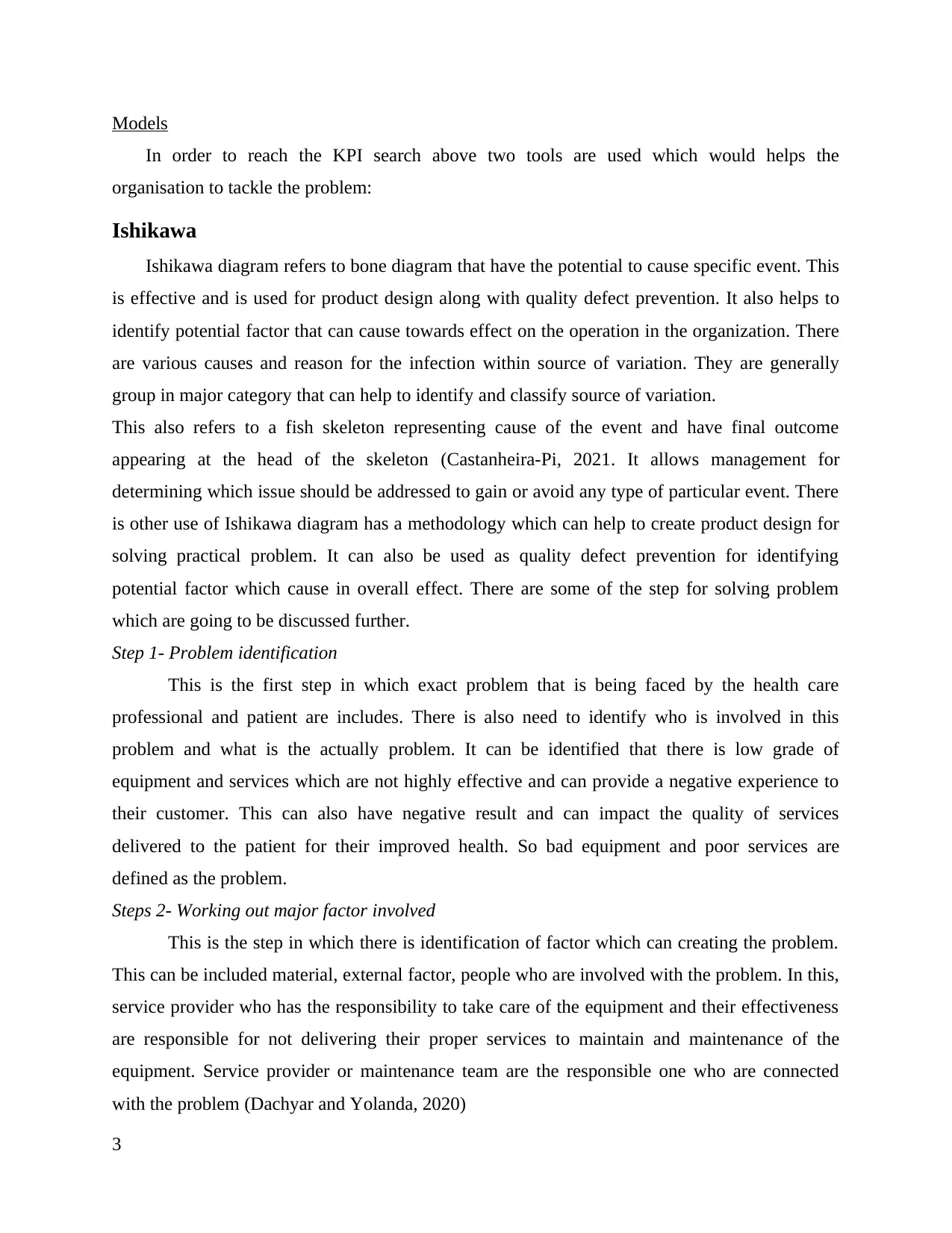
Models
In order to reach the KPI search above two tools are used which would helps the
organisation to tackle the problem:
Ishikawa
Ishikawa diagram refers to bone diagram that have the potential to cause specific event. This
is effective and is used for product design along with quality defect prevention. It also helps to
identify potential factor that can cause towards effect on the operation in the organization. There
are various causes and reason for the infection within source of variation. They are generally
group in major category that can help to identify and classify source of variation.
This also refers to a fish skeleton representing cause of the event and have final outcome
appearing at the head of the skeleton (Castanheira-Pi, 2021. It allows management for
determining which issue should be addressed to gain or avoid any type of particular event. There
is other use of Ishikawa diagram has a methodology which can help to create product design for
solving practical problem. It can also be used as quality defect prevention for identifying
potential factor which cause in overall effect. There are some of the step for solving problem
which are going to be discussed further.
Step 1- Problem identification
This is the first step in which exact problem that is being faced by the health care
professional and patient are includes. There is also need to identify who is involved in this
problem and what is the actually problem. It can be identified that there is low grade of
equipment and services which are not highly effective and can provide a negative experience to
their customer. This can also have negative result and can impact the quality of services
delivered to the patient for their improved health. So bad equipment and poor services are
defined as the problem.
Steps 2- Working out major factor involved
This is the step in which there is identification of factor which can creating the problem.
This can be included material, external factor, people who are involved with the problem. In this,
service provider who has the responsibility to take care of the equipment and their effectiveness
are responsible for not delivering their proper services to maintain and maintenance of the
equipment. Service provider or maintenance team are the responsible one who are connected
with the problem (Dachyar and Yolanda, 2020)
3
In order to reach the KPI search above two tools are used which would helps the
organisation to tackle the problem:
Ishikawa
Ishikawa diagram refers to bone diagram that have the potential to cause specific event. This
is effective and is used for product design along with quality defect prevention. It also helps to
identify potential factor that can cause towards effect on the operation in the organization. There
are various causes and reason for the infection within source of variation. They are generally
group in major category that can help to identify and classify source of variation.
This also refers to a fish skeleton representing cause of the event and have final outcome
appearing at the head of the skeleton (Castanheira-Pi, 2021. It allows management for
determining which issue should be addressed to gain or avoid any type of particular event. There
is other use of Ishikawa diagram has a methodology which can help to create product design for
solving practical problem. It can also be used as quality defect prevention for identifying
potential factor which cause in overall effect. There are some of the step for solving problem
which are going to be discussed further.
Step 1- Problem identification
This is the first step in which exact problem that is being faced by the health care
professional and patient are includes. There is also need to identify who is involved in this
problem and what is the actually problem. It can be identified that there is low grade of
equipment and services which are not highly effective and can provide a negative experience to
their customer. This can also have negative result and can impact the quality of services
delivered to the patient for their improved health. So bad equipment and poor services are
defined as the problem.
Steps 2- Working out major factor involved
This is the step in which there is identification of factor which can creating the problem.
This can be included material, external factor, people who are involved with the problem. In this,
service provider who has the responsibility to take care of the equipment and their effectiveness
are responsible for not delivering their proper services to maintain and maintenance of the
equipment. Service provider or maintenance team are the responsible one who are connected
with the problem (Dachyar and Yolanda, 2020)
3
Paraphrase This Document
Need a fresh take? Get an instant paraphrase of this document with our AI Paraphraser
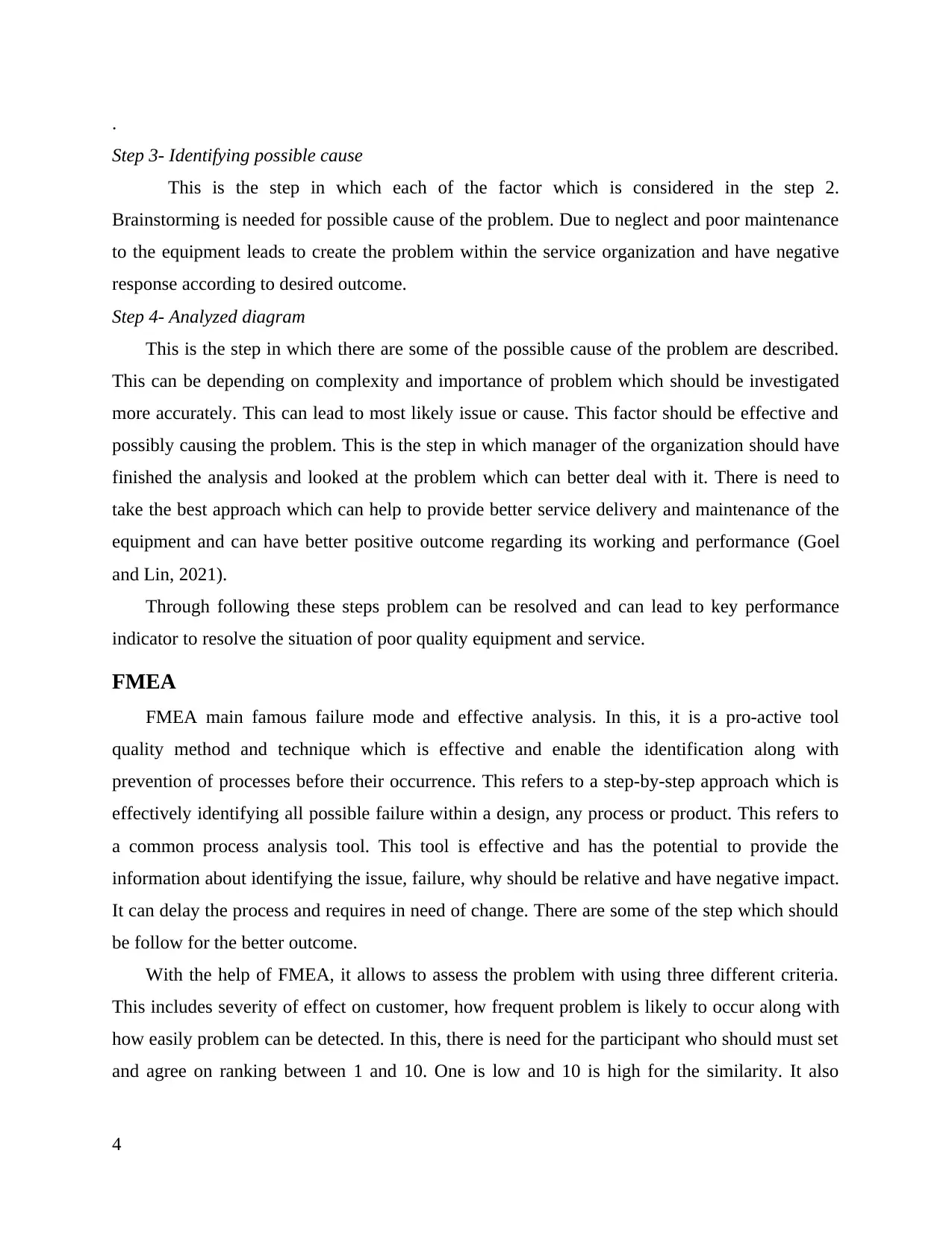
.
Step 3- Identifying possible cause
This is the step in which each of the factor which is considered in the step 2.
Brainstorming is needed for possible cause of the problem. Due to neglect and poor maintenance
to the equipment leads to create the problem within the service organization and have negative
response according to desired outcome.
Step 4- Analyzed diagram
This is the step in which there are some of the possible cause of the problem are described.
This can be depending on complexity and importance of problem which should be investigated
more accurately. This can lead to most likely issue or cause. This factor should be effective and
possibly causing the problem. This is the step in which manager of the organization should have
finished the analysis and looked at the problem which can better deal with it. There is need to
take the best approach which can help to provide better service delivery and maintenance of the
equipment and can have better positive outcome regarding its working and performance (Goel
and Lin, 2021).
Through following these steps problem can be resolved and can lead to key performance
indicator to resolve the situation of poor quality equipment and service.
FMEA
FMEA main famous failure mode and effective analysis. In this, it is a pro-active tool
quality method and technique which is effective and enable the identification along with
prevention of processes before their occurrence. This refers to a step-by-step approach which is
effectively identifying all possible failure within a design, any process or product. This refers to
a common process analysis tool. This tool is effective and has the potential to provide the
information about identifying the issue, failure, why should be relative and have negative impact.
It can delay the process and requires in need of change. There are some of the step which should
be follow for the better outcome.
With the help of FMEA, it allows to assess the problem with using three different criteria.
This includes severity of effect on customer, how frequent problem is likely to occur along with
how easily problem can be detected. In this, there is need for the participant who should must set
and agree on ranking between 1 and 10. One is low and 10 is high for the similarity. It also
4
Step 3- Identifying possible cause
This is the step in which each of the factor which is considered in the step 2.
Brainstorming is needed for possible cause of the problem. Due to neglect and poor maintenance
to the equipment leads to create the problem within the service organization and have negative
response according to desired outcome.
Step 4- Analyzed diagram
This is the step in which there are some of the possible cause of the problem are described.
This can be depending on complexity and importance of problem which should be investigated
more accurately. This can lead to most likely issue or cause. This factor should be effective and
possibly causing the problem. This is the step in which manager of the organization should have
finished the analysis and looked at the problem which can better deal with it. There is need to
take the best approach which can help to provide better service delivery and maintenance of the
equipment and can have better positive outcome regarding its working and performance (Goel
and Lin, 2021).
Through following these steps problem can be resolved and can lead to key performance
indicator to resolve the situation of poor quality equipment and service.
FMEA
FMEA main famous failure mode and effective analysis. In this, it is a pro-active tool
quality method and technique which is effective and enable the identification along with
prevention of processes before their occurrence. This refers to a step-by-step approach which is
effectively identifying all possible failure within a design, any process or product. This refers to
a common process analysis tool. This tool is effective and has the potential to provide the
information about identifying the issue, failure, why should be relative and have negative impact.
It can delay the process and requires in need of change. There are some of the step which should
be follow for the better outcome.
With the help of FMEA, it allows to assess the problem with using three different criteria.
This includes severity of effect on customer, how frequent problem is likely to occur along with
how easily problem can be detected. In this, there is need for the participant who should must set
and agree on ranking between 1 and 10. One is low and 10 is high for the similarity. It also
4
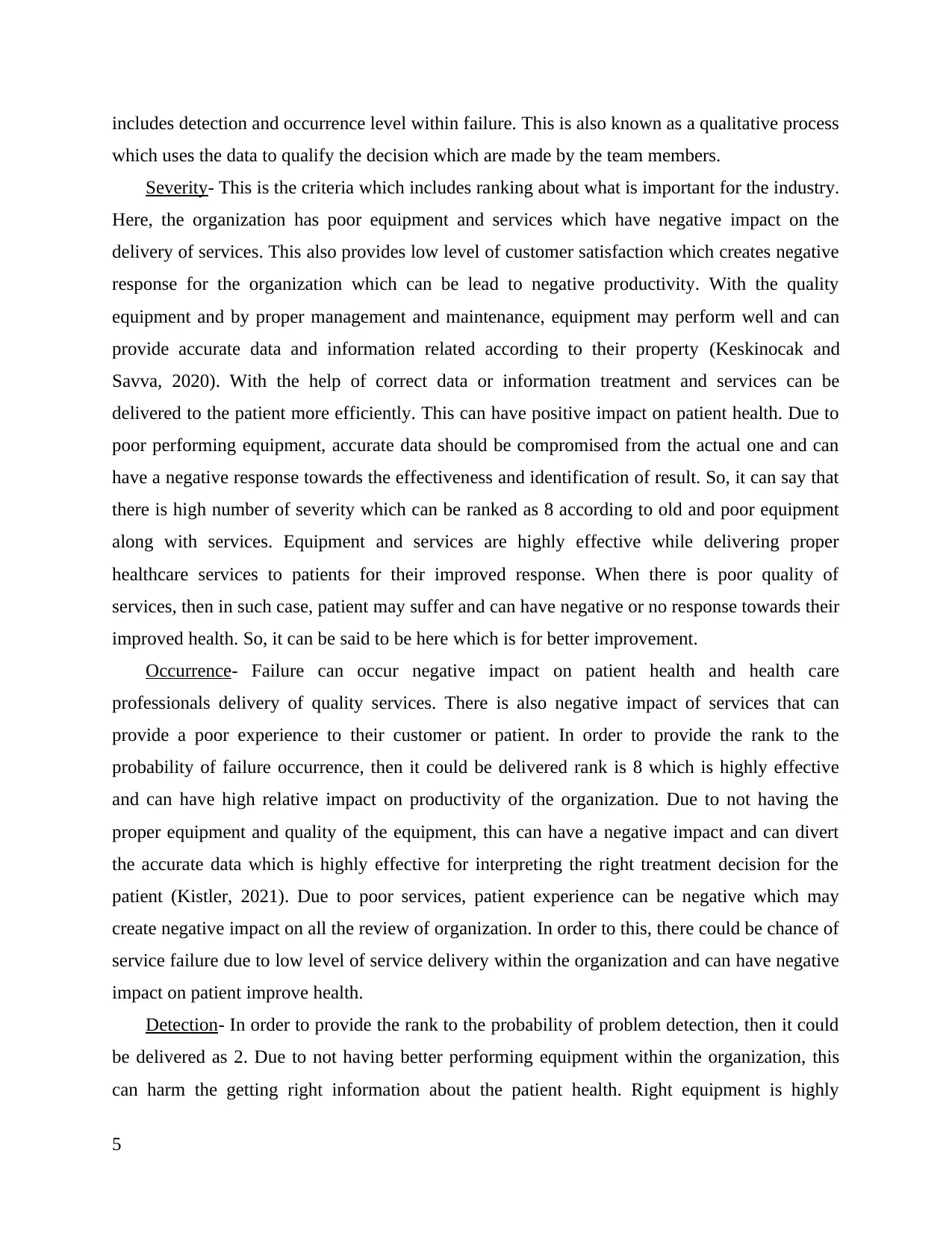
includes detection and occurrence level within failure. This is also known as a qualitative process
which uses the data to qualify the decision which are made by the team members.
Severity- This is the criteria which includes ranking about what is important for the industry.
Here, the organization has poor equipment and services which have negative impact on the
delivery of services. This also provides low level of customer satisfaction which creates negative
response for the organization which can be lead to negative productivity. With the quality
equipment and by proper management and maintenance, equipment may perform well and can
provide accurate data and information related according to their property (Keskinocak and
Savva, 2020). With the help of correct data or information treatment and services can be
delivered to the patient more efficiently. This can have positive impact on patient health. Due to
poor performing equipment, accurate data should be compromised from the actual one and can
have a negative response towards the effectiveness and identification of result. So, it can say that
there is high number of severity which can be ranked as 8 according to old and poor equipment
along with services. Equipment and services are highly effective while delivering proper
healthcare services to patients for their improved response. When there is poor quality of
services, then in such case, patient may suffer and can have negative or no response towards their
improved health. So, it can be said to be here which is for better improvement.
Occurrence- Failure can occur negative impact on patient health and health care
professionals delivery of quality services. There is also negative impact of services that can
provide a poor experience to their customer or patient. In order to provide the rank to the
probability of failure occurrence, then it could be delivered rank is 8 which is highly effective
and can have high relative impact on productivity of the organization. Due to not having the
proper equipment and quality of the equipment, this can have a negative impact and can divert
the accurate data which is highly effective for interpreting the right treatment decision for the
patient (Kistler, 2021). Due to poor services, patient experience can be negative which may
create negative impact on all the review of organization. In order to this, there could be chance of
service failure due to low level of service delivery within the organization and can have negative
impact on patient improve health.
Detection- In order to provide the rank to the probability of problem detection, then it could
be delivered as 2. Due to not having better performing equipment within the organization, this
can harm the getting right information about the patient health. Right equipment is highly
5
which uses the data to qualify the decision which are made by the team members.
Severity- This is the criteria which includes ranking about what is important for the industry.
Here, the organization has poor equipment and services which have negative impact on the
delivery of services. This also provides low level of customer satisfaction which creates negative
response for the organization which can be lead to negative productivity. With the quality
equipment and by proper management and maintenance, equipment may perform well and can
provide accurate data and information related according to their property (Keskinocak and
Savva, 2020). With the help of correct data or information treatment and services can be
delivered to the patient more efficiently. This can have positive impact on patient health. Due to
poor performing equipment, accurate data should be compromised from the actual one and can
have a negative response towards the effectiveness and identification of result. So, it can say that
there is high number of severity which can be ranked as 8 according to old and poor equipment
along with services. Equipment and services are highly effective while delivering proper
healthcare services to patients for their improved response. When there is poor quality of
services, then in such case, patient may suffer and can have negative or no response towards their
improved health. So, it can be said to be here which is for better improvement.
Occurrence- Failure can occur negative impact on patient health and health care
professionals delivery of quality services. There is also negative impact of services that can
provide a poor experience to their customer or patient. In order to provide the rank to the
probability of failure occurrence, then it could be delivered rank is 8 which is highly effective
and can have high relative impact on productivity of the organization. Due to not having the
proper equipment and quality of the equipment, this can have a negative impact and can divert
the accurate data which is highly effective for interpreting the right treatment decision for the
patient (Kistler, 2021). Due to poor services, patient experience can be negative which may
create negative impact on all the review of organization. In order to this, there could be chance of
service failure due to low level of service delivery within the organization and can have negative
impact on patient improve health.
Detection- In order to provide the rank to the probability of problem detection, then it could
be delivered as 2. Due to not having better performing equipment within the organization, this
can harm the getting right information about the patient health. Right equipment is highly
5
⊘ This is a preview!⊘
Do you want full access?
Subscribe today to unlock all pages.

Trusted by 1+ million students worldwide
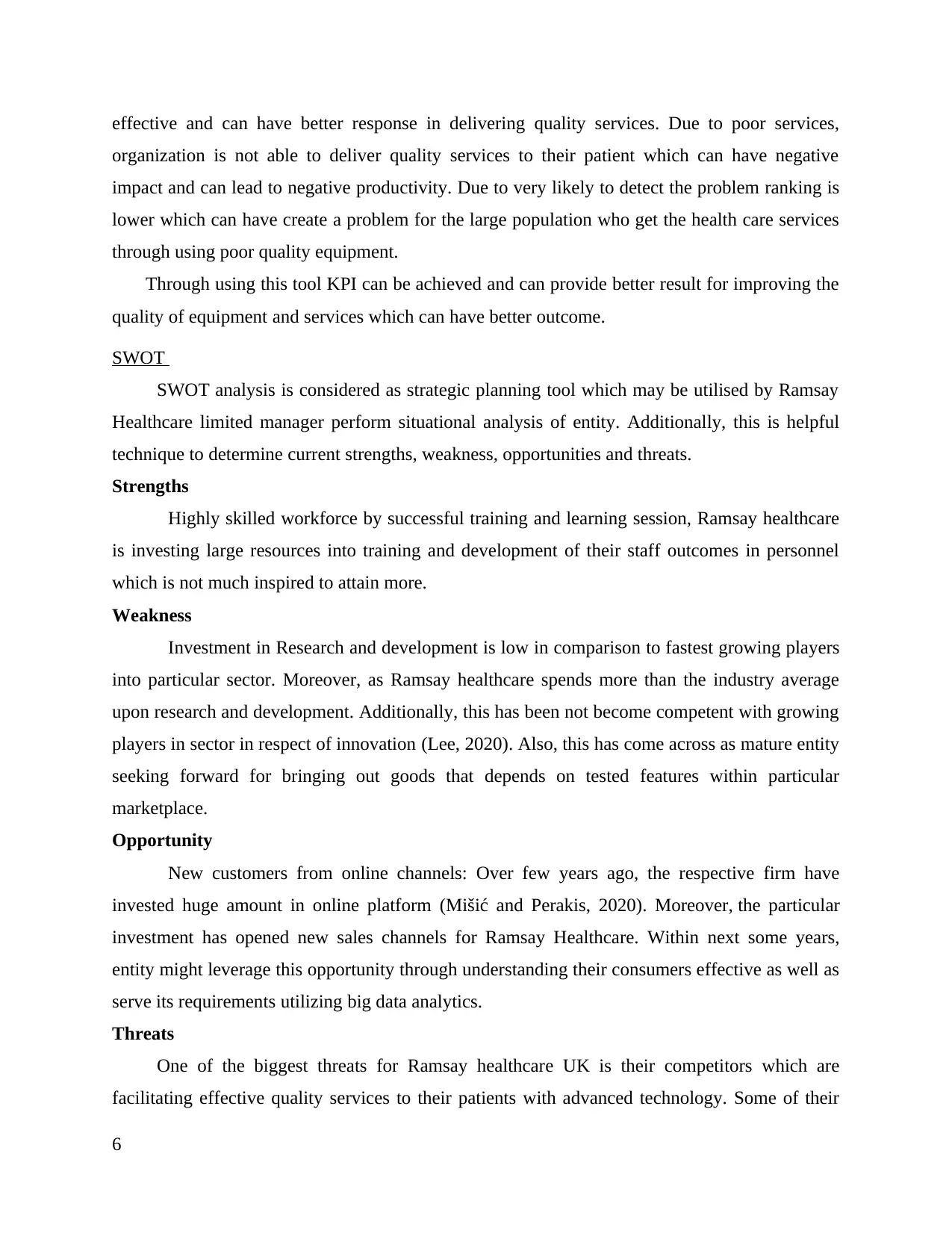
effective and can have better response in delivering quality services. Due to poor services,
organization is not able to deliver quality services to their patient which can have negative
impact and can lead to negative productivity. Due to very likely to detect the problem ranking is
lower which can have create a problem for the large population who get the health care services
through using poor quality equipment.
Through using this tool KPI can be achieved and can provide better result for improving the
quality of equipment and services which can have better outcome.
SWOT
SWOT analysis is considered as strategic planning tool which may be utilised by Ramsay
Healthcare limited manager perform situational analysis of entity. Additionally, this is helpful
technique to determine current strengths, weakness, opportunities and threats.
Strengths
Highly skilled workforce by successful training and learning session, Ramsay healthcare
is investing large resources into training and development of their staff outcomes in personnel
which is not much inspired to attain more.
Weakness
Investment in Research and development is low in comparison to fastest growing players
into particular sector. Moreover, as Ramsay healthcare spends more than the industry average
upon research and development. Additionally, this has been not become competent with growing
players in sector in respect of innovation (Lee, 2020). Also, this has come across as mature entity
seeking forward for bringing out goods that depends on tested features within particular
marketplace.
Opportunity
New customers from online channels: Over few years ago, the respective firm have
invested huge amount in online platform (Mišić and Perakis, 2020). Moreover, the particular
investment has opened new sales channels for Ramsay Healthcare. Within next some years,
entity might leverage this opportunity through understanding their consumers effective as well as
serve its requirements utilizing big data analytics.
Threats
One of the biggest threats for Ramsay healthcare UK is their competitors which are
facilitating effective quality services to their patients with advanced technology. Some of their
6
organization is not able to deliver quality services to their patient which can have negative
impact and can lead to negative productivity. Due to very likely to detect the problem ranking is
lower which can have create a problem for the large population who get the health care services
through using poor quality equipment.
Through using this tool KPI can be achieved and can provide better result for improving the
quality of equipment and services which can have better outcome.
SWOT
SWOT analysis is considered as strategic planning tool which may be utilised by Ramsay
Healthcare limited manager perform situational analysis of entity. Additionally, this is helpful
technique to determine current strengths, weakness, opportunities and threats.
Strengths
Highly skilled workforce by successful training and learning session, Ramsay healthcare
is investing large resources into training and development of their staff outcomes in personnel
which is not much inspired to attain more.
Weakness
Investment in Research and development is low in comparison to fastest growing players
into particular sector. Moreover, as Ramsay healthcare spends more than the industry average
upon research and development. Additionally, this has been not become competent with growing
players in sector in respect of innovation (Lee, 2020). Also, this has come across as mature entity
seeking forward for bringing out goods that depends on tested features within particular
marketplace.
Opportunity
New customers from online channels: Over few years ago, the respective firm have
invested huge amount in online platform (Mišić and Perakis, 2020). Moreover, the particular
investment has opened new sales channels for Ramsay Healthcare. Within next some years,
entity might leverage this opportunity through understanding their consumers effective as well as
serve its requirements utilizing big data analytics.
Threats
One of the biggest threats for Ramsay healthcare UK is their competitors which are
facilitating effective quality services to their patients with advanced technology. Some of their
6
Paraphrase This Document
Need a fresh take? Get an instant paraphrase of this document with our AI Paraphraser
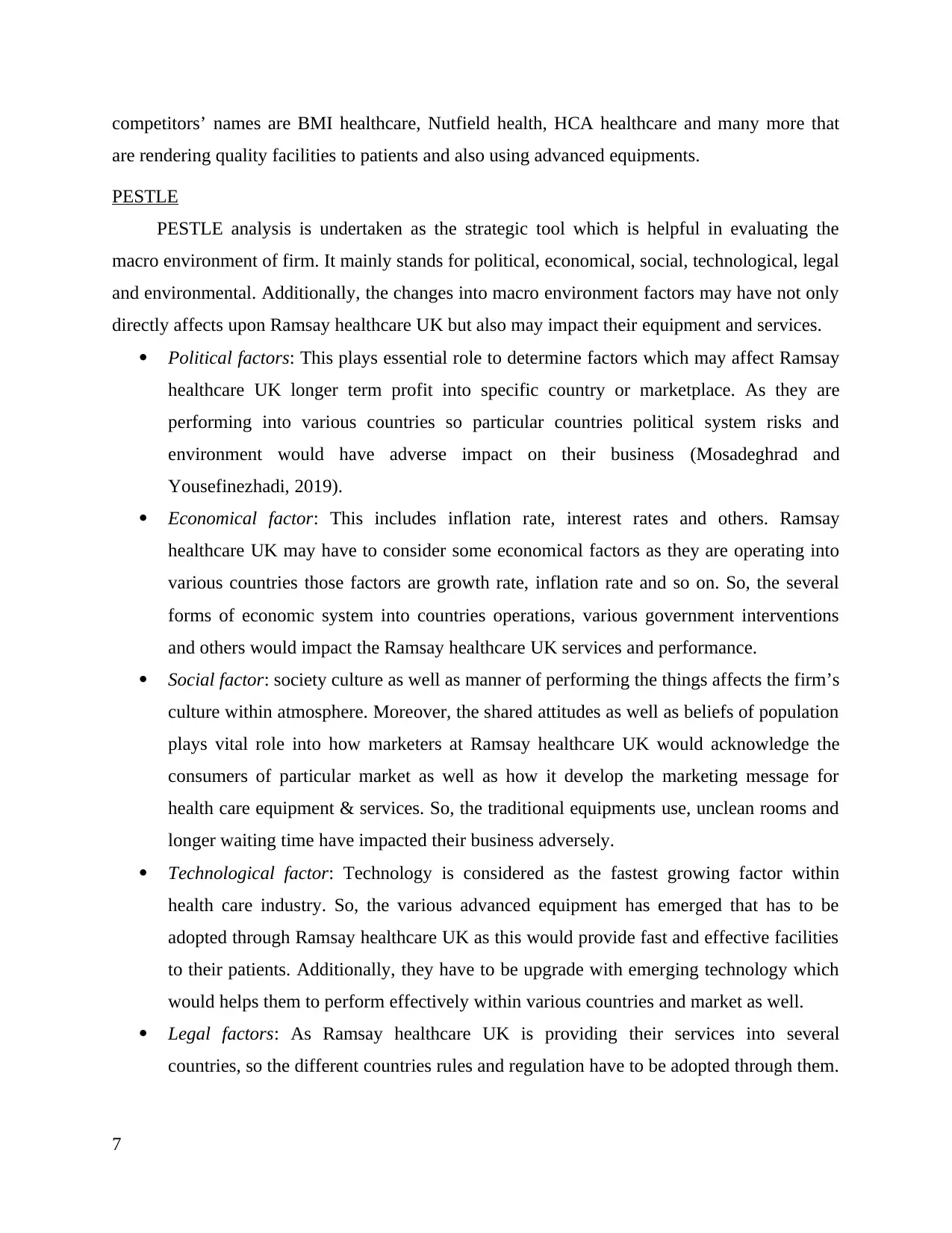
competitors’ names are BMI healthcare, Nutfield health, HCA healthcare and many more that
are rendering quality facilities to patients and also using advanced equipments.
PESTLE
PESTLE analysis is undertaken as the strategic tool which is helpful in evaluating the
macro environment of firm. It mainly stands for political, economical, social, technological, legal
and environmental. Additionally, the changes into macro environment factors may have not only
directly affects upon Ramsay healthcare UK but also may impact their equipment and services.
Political factors: This plays essential role to determine factors which may affect Ramsay
healthcare UK longer term profit into specific country or marketplace. As they are
performing into various countries so particular countries political system risks and
environment would have adverse impact on their business (Mosadeghrad and
Yousefinezhadi, 2019).
Economical factor: This includes inflation rate, interest rates and others. Ramsay
healthcare UK may have to consider some economical factors as they are operating into
various countries those factors are growth rate, inflation rate and so on. So, the several
forms of economic system into countries operations, various government interventions
and others would impact the Ramsay healthcare UK services and performance.
Social factor: society culture as well as manner of performing the things affects the firm’s
culture within atmosphere. Moreover, the shared attitudes as well as beliefs of population
plays vital role into how marketers at Ramsay healthcare UK would acknowledge the
consumers of particular market as well as how it develop the marketing message for
health care equipment & services. So, the traditional equipments use, unclean rooms and
longer waiting time have impacted their business adversely.
Technological factor: Technology is considered as the fastest growing factor within
health care industry. So, the various advanced equipment has emerged that has to be
adopted through Ramsay healthcare UK as this would provide fast and effective facilities
to their patients. Additionally, they have to be upgrade with emerging technology which
would helps them to perform effectively within various countries and market as well.
Legal factors: As Ramsay healthcare UK is providing their services into several
countries, so the different countries rules and regulation have to be adopted through them.
7
are rendering quality facilities to patients and also using advanced equipments.
PESTLE
PESTLE analysis is undertaken as the strategic tool which is helpful in evaluating the
macro environment of firm. It mainly stands for political, economical, social, technological, legal
and environmental. Additionally, the changes into macro environment factors may have not only
directly affects upon Ramsay healthcare UK but also may impact their equipment and services.
Political factors: This plays essential role to determine factors which may affect Ramsay
healthcare UK longer term profit into specific country or marketplace. As they are
performing into various countries so particular countries political system risks and
environment would have adverse impact on their business (Mosadeghrad and
Yousefinezhadi, 2019).
Economical factor: This includes inflation rate, interest rates and others. Ramsay
healthcare UK may have to consider some economical factors as they are operating into
various countries those factors are growth rate, inflation rate and so on. So, the several
forms of economic system into countries operations, various government interventions
and others would impact the Ramsay healthcare UK services and performance.
Social factor: society culture as well as manner of performing the things affects the firm’s
culture within atmosphere. Moreover, the shared attitudes as well as beliefs of population
plays vital role into how marketers at Ramsay healthcare UK would acknowledge the
consumers of particular market as well as how it develop the marketing message for
health care equipment & services. So, the traditional equipments use, unclean rooms and
longer waiting time have impacted their business adversely.
Technological factor: Technology is considered as the fastest growing factor within
health care industry. So, the various advanced equipment has emerged that has to be
adopted through Ramsay healthcare UK as this would provide fast and effective facilities
to their patients. Additionally, they have to be upgrade with emerging technology which
would helps them to perform effectively within various countries and market as well.
Legal factors: As Ramsay healthcare UK is providing their services into several
countries, so the different countries rules and regulation have to be adopted through them.
7
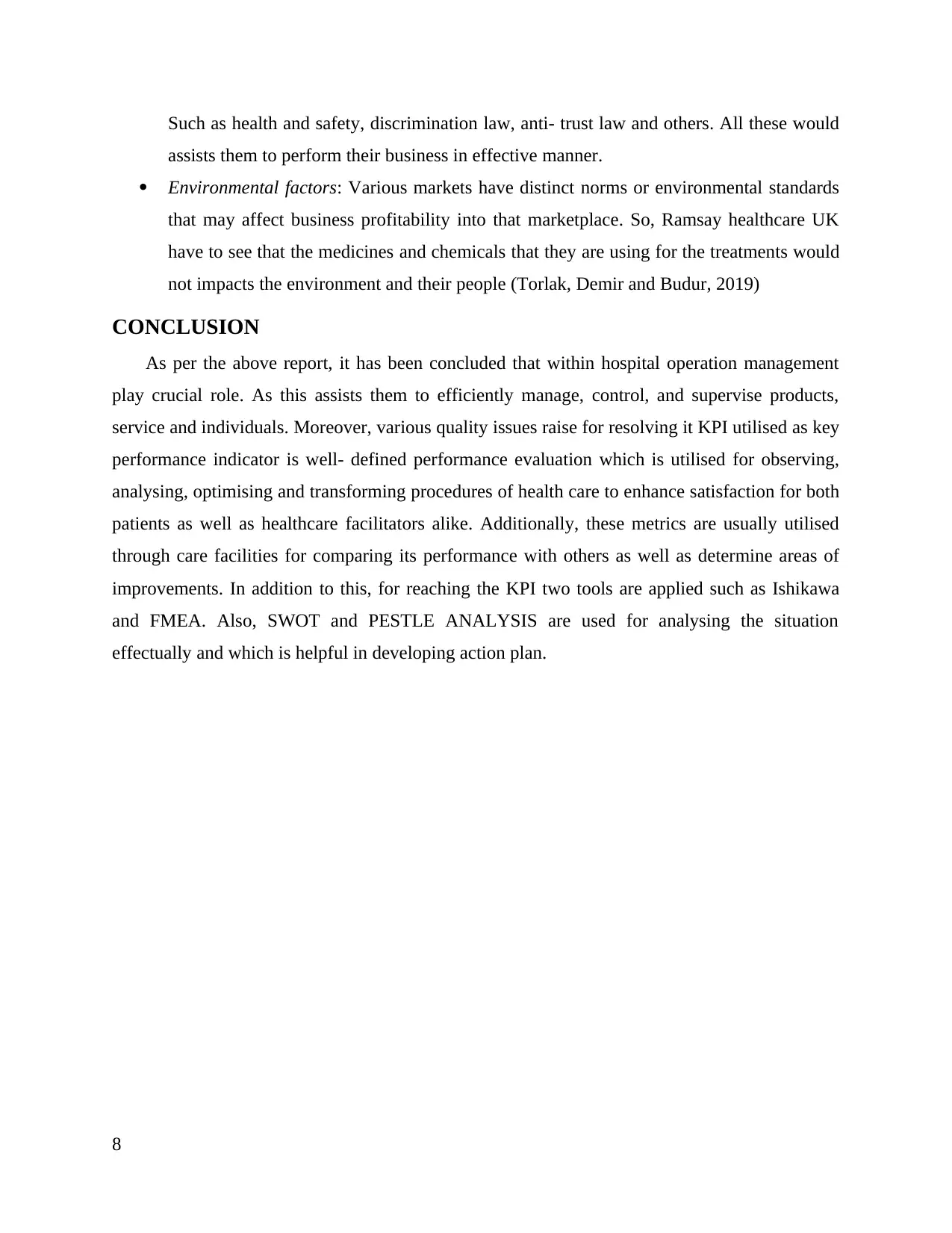
Such as health and safety, discrimination law, anti- trust law and others. All these would
assists them to perform their business in effective manner.
Environmental factors: Various markets have distinct norms or environmental standards
that may affect business profitability into that marketplace. So, Ramsay healthcare UK
have to see that the medicines and chemicals that they are using for the treatments would
not impacts the environment and their people (Torlak, Demir and Budur, 2019)
CONCLUSION
As per the above report, it has been concluded that within hospital operation management
play crucial role. As this assists them to efficiently manage, control, and supervise products,
service and individuals. Moreover, various quality issues raise for resolving it KPI utilised as key
performance indicator is well- defined performance evaluation which is utilised for observing,
analysing, optimising and transforming procedures of health care to enhance satisfaction for both
patients as well as healthcare facilitators alike. Additionally, these metrics are usually utilised
through care facilities for comparing its performance with others as well as determine areas of
improvements. In addition to this, for reaching the KPI two tools are applied such as Ishikawa
and FMEA. Also, SWOT and PESTLE ANALYSIS are used for analysing the situation
effectually and which is helpful in developing action plan.
8
assists them to perform their business in effective manner.
Environmental factors: Various markets have distinct norms or environmental standards
that may affect business profitability into that marketplace. So, Ramsay healthcare UK
have to see that the medicines and chemicals that they are using for the treatments would
not impacts the environment and their people (Torlak, Demir and Budur, 2019)
CONCLUSION
As per the above report, it has been concluded that within hospital operation management
play crucial role. As this assists them to efficiently manage, control, and supervise products,
service and individuals. Moreover, various quality issues raise for resolving it KPI utilised as key
performance indicator is well- defined performance evaluation which is utilised for observing,
analysing, optimising and transforming procedures of health care to enhance satisfaction for both
patients as well as healthcare facilitators alike. Additionally, these metrics are usually utilised
through care facilities for comparing its performance with others as well as determine areas of
improvements. In addition to this, for reaching the KPI two tools are applied such as Ishikawa
and FMEA. Also, SWOT and PESTLE ANALYSIS are used for analysing the situation
effectually and which is helpful in developing action plan.
8
⊘ This is a preview!⊘
Do you want full access?
Subscribe today to unlock all pages.

Trusted by 1+ million students worldwide
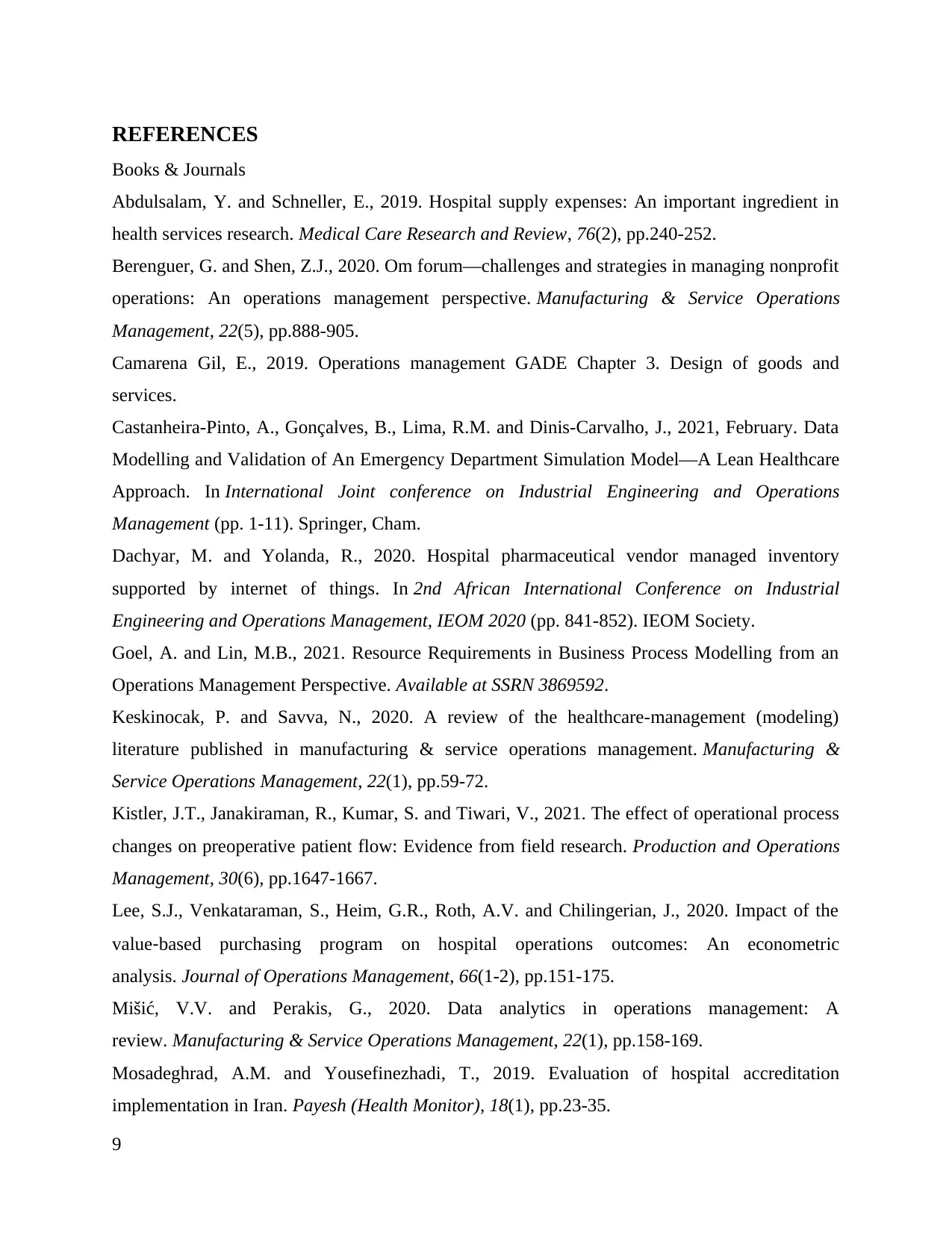
REFERENCES
Books & Journals
Abdulsalam, Y. and Schneller, E., 2019. Hospital supply expenses: An important ingredient in
health services research. Medical Care Research and Review, 76(2), pp.240-252.
Berenguer, G. and Shen, Z.J., 2020. Om forum—challenges and strategies in managing nonprofit
operations: An operations management perspective. Manufacturing & Service Operations
Management, 22(5), pp.888-905.
Camarena Gil, E., 2019. Operations management GADE Chapter 3. Design of goods and
services.
Castanheira-Pinto, A., Gonçalves, B., Lima, R.M. and Dinis-Carvalho, J., 2021, February. Data
Modelling and Validation of An Emergency Department Simulation Model—A Lean Healthcare
Approach. In International Joint conference on Industrial Engineering and Operations
Management (pp. 1-11). Springer, Cham.
Dachyar, M. and Yolanda, R., 2020. Hospital pharmaceutical vendor managed inventory
supported by internet of things. In 2nd African International Conference on Industrial
Engineering and Operations Management, IEOM 2020 (pp. 841-852). IEOM Society.
Goel, A. and Lin, M.B., 2021. Resource Requirements in Business Process Modelling from an
Operations Management Perspective. Available at SSRN 3869592.
Keskinocak, P. and Savva, N., 2020. A review of the healthcare-management (modeling)
literature published in manufacturing & service operations management. Manufacturing &
Service Operations Management, 22(1), pp.59-72.
Kistler, J.T., Janakiraman, R., Kumar, S. and Tiwari, V., 2021. The effect of operational process
changes on preoperative patient flow: Evidence from field research. Production and Operations
Management, 30(6), pp.1647-1667.
Lee, S.J., Venkataraman, S., Heim, G.R., Roth, A.V. and Chilingerian, J., 2020. Impact of the
value‐based purchasing program on hospital operations outcomes: An econometric
analysis. Journal of Operations Management, 66(1-2), pp.151-175.
Mišić, V.V. and Perakis, G., 2020. Data analytics in operations management: A
review. Manufacturing & Service Operations Management, 22(1), pp.158-169.
Mosadeghrad, A.M. and Yousefinezhadi, T., 2019. Evaluation of hospital accreditation
implementation in Iran. Payesh (Health Monitor), 18(1), pp.23-35.
9
Books & Journals
Abdulsalam, Y. and Schneller, E., 2019. Hospital supply expenses: An important ingredient in
health services research. Medical Care Research and Review, 76(2), pp.240-252.
Berenguer, G. and Shen, Z.J., 2020. Om forum—challenges and strategies in managing nonprofit
operations: An operations management perspective. Manufacturing & Service Operations
Management, 22(5), pp.888-905.
Camarena Gil, E., 2019. Operations management GADE Chapter 3. Design of goods and
services.
Castanheira-Pinto, A., Gonçalves, B., Lima, R.M. and Dinis-Carvalho, J., 2021, February. Data
Modelling and Validation of An Emergency Department Simulation Model—A Lean Healthcare
Approach. In International Joint conference on Industrial Engineering and Operations
Management (pp. 1-11). Springer, Cham.
Dachyar, M. and Yolanda, R., 2020. Hospital pharmaceutical vendor managed inventory
supported by internet of things. In 2nd African International Conference on Industrial
Engineering and Operations Management, IEOM 2020 (pp. 841-852). IEOM Society.
Goel, A. and Lin, M.B., 2021. Resource Requirements in Business Process Modelling from an
Operations Management Perspective. Available at SSRN 3869592.
Keskinocak, P. and Savva, N., 2020. A review of the healthcare-management (modeling)
literature published in manufacturing & service operations management. Manufacturing &
Service Operations Management, 22(1), pp.59-72.
Kistler, J.T., Janakiraman, R., Kumar, S. and Tiwari, V., 2021. The effect of operational process
changes on preoperative patient flow: Evidence from field research. Production and Operations
Management, 30(6), pp.1647-1667.
Lee, S.J., Venkataraman, S., Heim, G.R., Roth, A.V. and Chilingerian, J., 2020. Impact of the
value‐based purchasing program on hospital operations outcomes: An econometric
analysis. Journal of Operations Management, 66(1-2), pp.151-175.
Mišić, V.V. and Perakis, G., 2020. Data analytics in operations management: A
review. Manufacturing & Service Operations Management, 22(1), pp.158-169.
Mosadeghrad, A.M. and Yousefinezhadi, T., 2019. Evaluation of hospital accreditation
implementation in Iran. Payesh (Health Monitor), 18(1), pp.23-35.
9
Paraphrase This Document
Need a fresh take? Get an instant paraphrase of this document with our AI Paraphraser
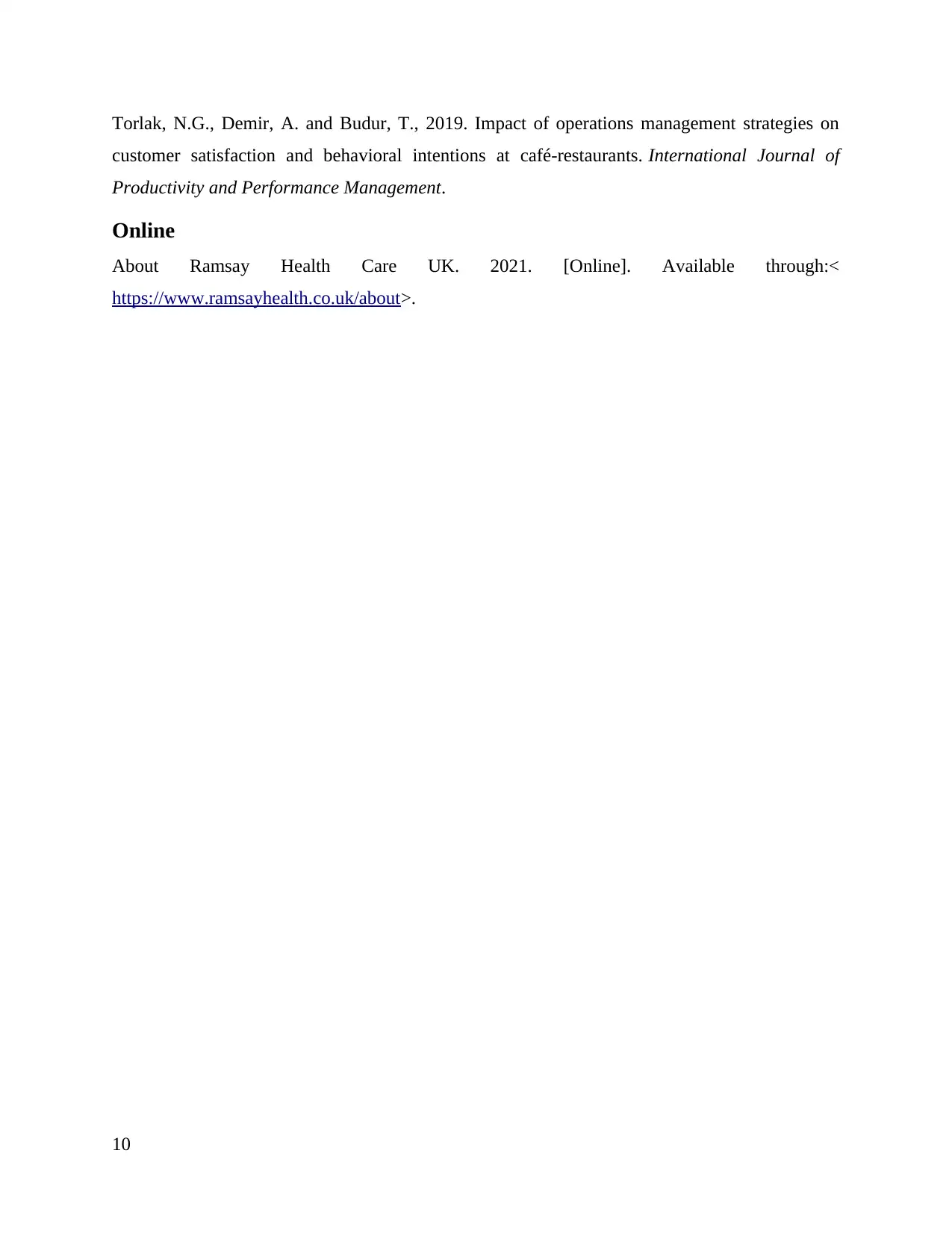
Torlak, N.G., Demir, A. and Budur, T., 2019. Impact of operations management strategies on
customer satisfaction and behavioral intentions at café-restaurants. International Journal of
Productivity and Performance Management.
Online
About Ramsay Health Care UK. 2021. [Online]. Available through:<
https://www.ramsayhealth.co.uk/about>.
10
customer satisfaction and behavioral intentions at café-restaurants. International Journal of
Productivity and Performance Management.
Online
About Ramsay Health Care UK. 2021. [Online]. Available through:<
https://www.ramsayhealth.co.uk/about>.
10
1 out of 11
Related Documents
Your All-in-One AI-Powered Toolkit for Academic Success.
+13062052269
info@desklib.com
Available 24*7 on WhatsApp / Email
![[object Object]](/_next/static/media/star-bottom.7253800d.svg)
Unlock your academic potential
Copyright © 2020–2025 A2Z Services. All Rights Reserved. Developed and managed by ZUCOL.



